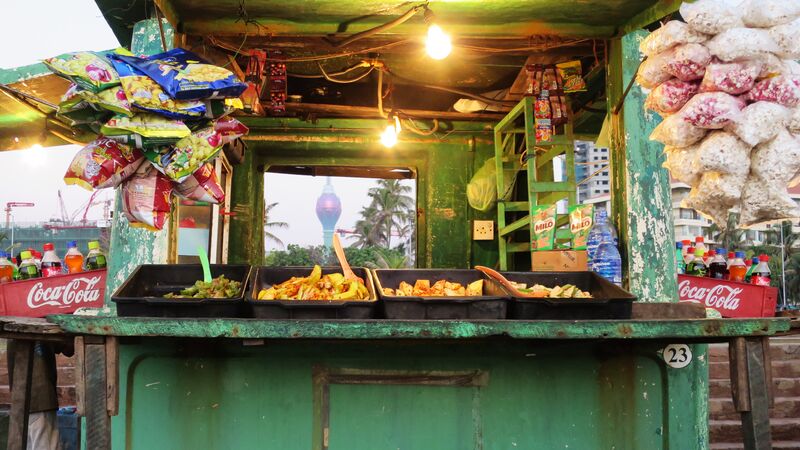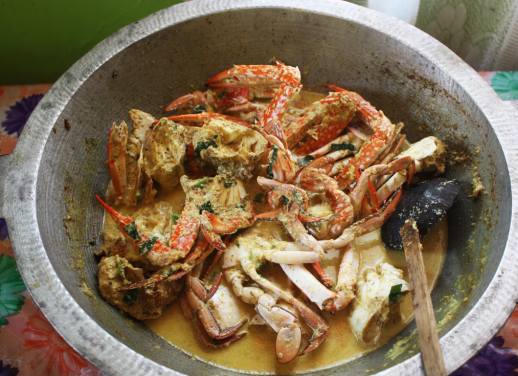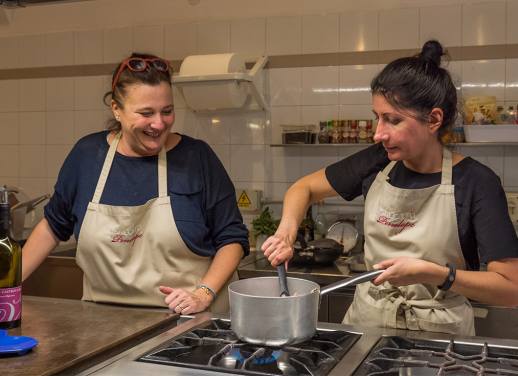Sri Lanka’s food is like a historical and cultural map of the island. You can sort of eat your way through the various waves of migration.
Crispy sweet Kokis came from the Netherlands. Samosas and lentil dhal drifted south from India (although you’ll find more mustard seeds and heavy spices here). And you can buy deep-fried ‘Chinese Rolls’ from street stalls in Colombo. But Tamil food is something different again.
The Tamil people have lived in Sri Lanka since around the second century BCE. These days, if you want proper Tamil cuisine, your best bet is the northern provinces, and especially Jaffna, although you’ll find Tamil-style restaurants all over the island. Sinhalese and Burgher cooking both have their charms, but if you want real heat, head north.
INTERESTED IN TRYING TAMIL FOOD? JOIN US ON A 12-DAY REAL FOOD ADVENTURE IN SRI LANKA NOW
Our beginner’s guide to Tamil food
What makes Tamil food amazing?
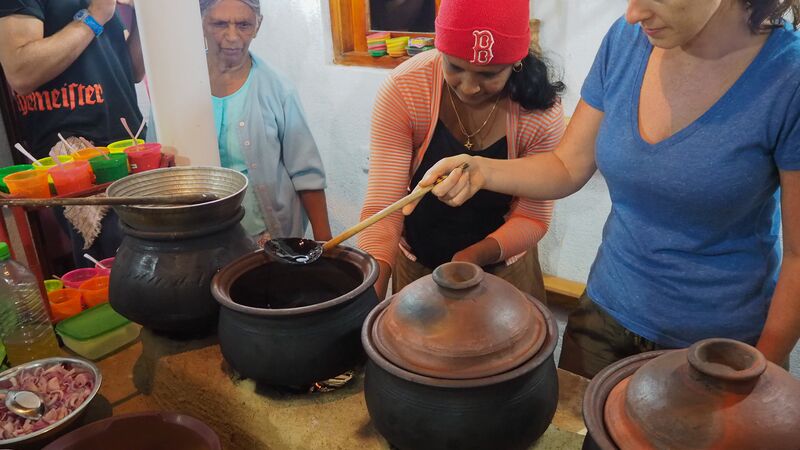
Intrepid travellers at a Tamil cooking class in Bandarawela .
Being so close to southern India, Tamil cuisine borrows a lot of spices from the mainland. It just tends to crank the flavour dial as far as it will go. There’s also plenty of seafood around the Jaffna peninsula, so instead of chicken or beef, you’re more likely to find your lunch curry stuffed with crab, shark, fish or prawns (goat meat is also pretty popular).
Seafood curries up here tend to feature dried palm fruit stalks, ground up into the spice mix. It gives them a real nutty hum. As you’d expect in Sri Lanka, most meals come with a range of achars (pickles), and dried coconut sambal. Turmeric and tamarind find their way into most of your meals. The idea is to eat a little bit of everything, and keep a glass of milk on stand-by.
EXPLORE OUR FULL RANGE OF ADVENTURES IN SRI LANKA NOW
Where can I get Tamil food?
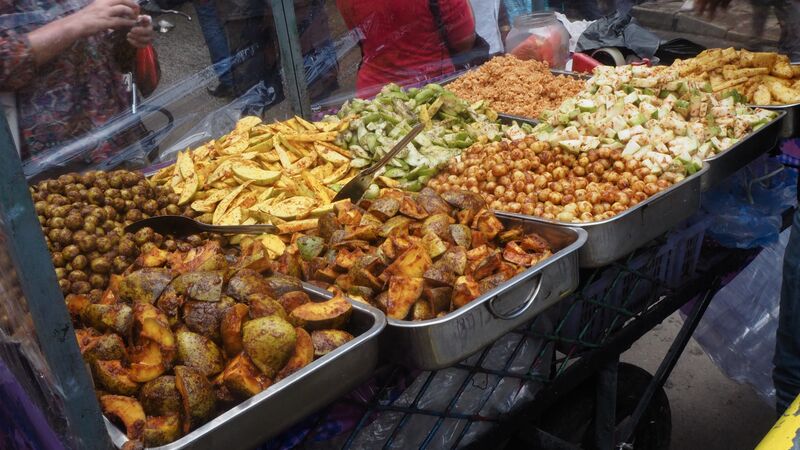
Trays of incredible food available from a street vendor.
The northern parts of Sri Lanka are generally considered the ‘home’ of Tamil cuisine, but you can find Tamil food all over the country. Colombo has several excellent Tamil restaurants (this blog is a good place to start), and you’ll spot Jaffna Curry on menus pretty much everywhere. If you want a more hands-on taste, check out our Sri Lanka Real Food Adventure. It includes a meal with a Tamil family in Bandarawela, and our local guides know all the best foodie hotspots.
Jaffna Curry
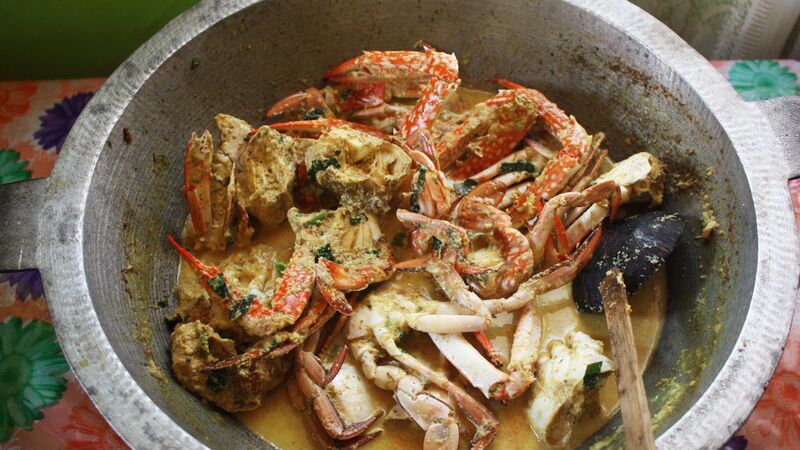
A mild Jaffna curry (they’re usually MUCH redder than this!)
You can tell a Jaffna Curry from the colour. It should look like the promise of future pain: a deep, fiery crimson. There’s about eleven spices in a proper Jaffna curry, including coriander seeds, fennel seeds, fenugreek seeds, cardamom and cinnamon, but the key ingredient is a big handful of dried red chillies. Everything gets simmered with tomato paste and coconut milk, and the smell will stay with you (and your clothes) long after the meal’s over. The locals usually serve this one with goat or seafood. You’ll find this all over the northern peninsula, but if you’re in Colombo, try restaurants like Palmyrah, Shanmugas or Taste Of Asia.
Appam
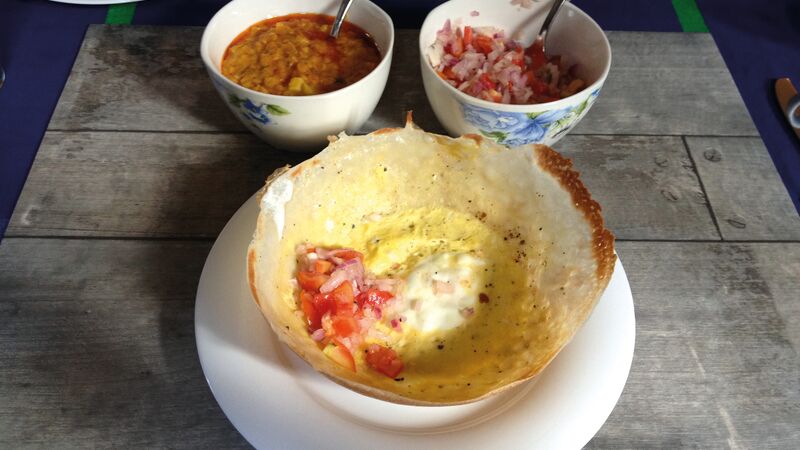
Appam is a great way to start the day.
You might know appam by its more common name, ‘hopper’. It’s a crispy, bowl-like pancake, made from fermented rice batter and coconut milk, and it’s a big part of Tamil cuisine. Think of them as a more useful crepe: crispy on the outside and spongey on the middle, the perfect receptacles for Suwandel rice and red chilli sambal. There are a couple of appam variants, including egg appam (basically a cracked egg at the bottom of the hopper) and milk appam (a big Tamil favourite). Most cooks also add a splash of toddy (Sri Lankan palm wine) to the batter. If you’re lucky, you might come across sweet variants, which come drizzled in jiggery (Sri Lankan dark palm sugar) and a dollop of coconut cream.
RELATED: 5 BREAKFASTS YOU HAVE TO TRY IN SRI LANKA, ACCORDING TO A LOCAL
Murukku
Murukku are the Tamil equivalent of roadside doughnuts. Crunchy, savoury, flash-fried in vegetable oil, and ridiculously moreish. They’re made from rice flour and urad dal flour, mixed with chilli powder, salt and cumin seeds. The dough is wrangled into a scraggly, spaghetti-type coil (‘Murukku’ means twisted in Tamil) and then fried to a crisp. You’ll find them at roadside stalls all over Jaffna. There are a few regional variations, depending on where you travel, but the most famous are the Manapparai murukku from Manapparai, a town in India’s Tamil Nadu (if you’re visiting the mainland). The water there is particularly salty, which has given their murukku a cult following.
Puttu
Another Tamil recipe you’ll find all over southern India is puttu (or sometimes pittu). These are basically cylinders of steamed coconut rice, which you can tweak a hundred different ways. Sometimes they’re served with palm sugar and banana, other times with chickpea curry, fried fish or a fiery sambal. Puttu’s flexibility means you can eat them for pretty much any meal; a couple of these for breakfast and you’ll be full for hours. You’ll spot them at roadside stalls all over Jaffna, usually emerging from a steaming copper puttu kadam.
RELATED: WHY SRI LANKA IS THE PERFECT DESTINATION FOR VEGETARIANS & VEGANS
Kiri Toffee
If you’re lucky enough to be travelling in Jaffna for Tamil New Year (around the 14th April), try and get your hands on some authentic Kiri (milk) or Pol (coconut) toffee. They’re traditional sweet snacks that always emerge for big celebrations in Sri Lanka. Kiri toffee is our personal favourite: it’s made from sugar syrup and sweetened condensed milk, forged into ragged chunks of caramel-y goodness. Sometimes you’ll find chopped cashew nuts in there for extra crunch.
Ready to eat ALL the food in Sri Lanka? Join us on our 12-day Real Food Adventure around Sri Lanka now. Details here.
All images c/o Intrepid Travel.

